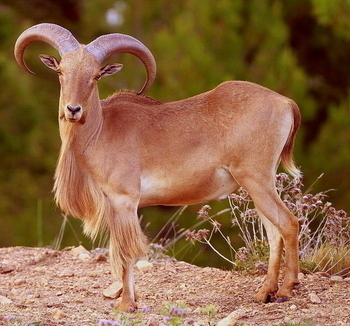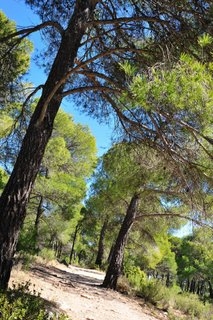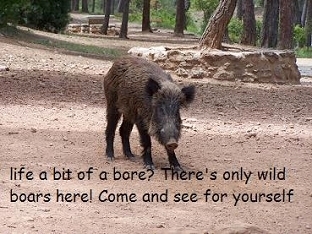
To be listed on the haciendadelalamo TODAY MAP please call +34 968 018 268.
General Information Sierra Espuña
Sierra Espuña Flora and Fauna
 The vast forests of the Sierra Espuña create a haven for wildlife, and the variety of conditions ensure a wide variety of specimens for those with an interest in nature, flora and fauna.
The vast forests of the Sierra Espuña create a haven for wildlife, and the variety of conditions ensure a wide variety of specimens for those with an interest in nature, flora and fauna.
The Ricardo Codorníu visitor centre has a large amount of information available about the wildlife in the area, and a good display showing some of the species and specimens to be found in the Sierra Espuña. ( Click Ricardo Codorníu visitor centre)
Flora
 The predominant species of tree in the Sierra Espuña is the Aleppo Pine, although on higher ground it gives way to the European Black Pine. There are also small areas of Holm Oaks, Portuguese Oaks and maple trees.
The predominant species of tree in the Sierra Espuña is the Aleppo Pine, although on higher ground it gives way to the European Black Pine. There are also small areas of Holm Oaks, Portuguese Oaks and maple trees.
Around the water run-off channels and near the natural springs there are areas abounding in elms, poplars and black poplars, together with a wide range of bushy plants including honeysuckle, wild roses and sarsaparilla.
On some of the slopes the undergrowth is very thick, consisting of Kermes oaks, mastic, hawthorns, juniper and Cane apples among others. The differences between the slopes facing in different directions and with different types of exposure to the sun can be easily seen by the differences in the vegetation growing throughout the Sierra Espuña.
On the peaks, the vegetation is characterised by the need to adapt to the extreme weather conditions, and consists mainly of broom (“Nun’s cushion”) and scale-leaf junipers.
Fauna
 There is quite a lot of variety in the composition of the local fauna. Among the insects present are some species which are unique to these mountains, such as the Spanish Argus species of butterfly, and the amphibians in the sierra include the natterjack toad and the Iberian painted frog. The reptile population of the park includes the ocellated lizard, the snub-nosed viper and the Montpelliersnake.
There is quite a lot of variety in the composition of the local fauna. Among the insects present are some species which are unique to these mountains, such as the Spanish Argus species of butterfly, and the amphibians in the sierra include the natterjack toad and the Iberian painted frog. The reptile population of the park includes the ocellated lizard, the snub-nosed viper and the Montpelliersnake.
But it is for its birdlife that the Sierra Espuña is most famed. The dense forests provide perfect homes for great tits, crossbill finches and long-tailed tits. As for birds of prey, during the day the goshawk and the sparrowhawk constantly patrol the skies, while at night the Park of Sierra Espuña is one of the few places in the Region of Murcia where the calls of eagle owls and true owls can be heard.
The edges of the pine forest and the hedgerows are home to buntings, thrushes and finches, and there are also sizeable populations of booted eagles and golden eagles. The presence of some of these species has led to the area being declared a Special Birdlife Protection Zone (ZEPA) of importance within the European Community.
 Without any doubt the star mammal in the sierra is the Barbary sheep, the Arrui. This is not a native of the Park but is an “exotic” introduction to the area dating back to 1970, when it was brought to the area by hunters. The population of the species in the sierra has grown rapidly, and the area was made a national hunting reserve in 1973.
Without any doubt the star mammal in the sierra is the Barbary sheep, the Arrui. This is not a native of the Park but is an “exotic” introduction to the area dating back to 1970, when it was brought to the area by hunters. The population of the species in the sierra has grown rapidly, and the area was made a national hunting reserve in 1973.
During 2011, ecologists and farmers campaigned to have the arrui exterminated from the area, arguing that it was breeding too rapidly, the flocks were becoming too large and damaging farming crops, but the decision was finally taken to safeguard the species and permit selective hunting to control numbers. Hunting is big business, and the hunting rights to hunt the larger specimens, which are auctioned off, fetch a lot of money.
See Barbary sheep spared wholesale execution
Mula auctions off licences to hunt Barbary sheep
Farmers call for erradication of Arrui from Sierra Espuña.
Another species which is very prominent in the Sierra Espuña is the wild boar, or Jabalí, as it´s known locally. The boar do an incredible amount of damage to crops and their numbers are increasing rapidly, as less farmers habitually hunt. There is evidence of boar right across the forest floor, turfed up soil looking as though a rotovator has been through the forest. At one of the rest areas, Fuente del Hilo, the boar are fed in the evenings, so this is a good place to head for if you´ve never seen one before and would like to.
Other mammal species here include squirrels, ( red!) dormice, European genets and wildcats.


